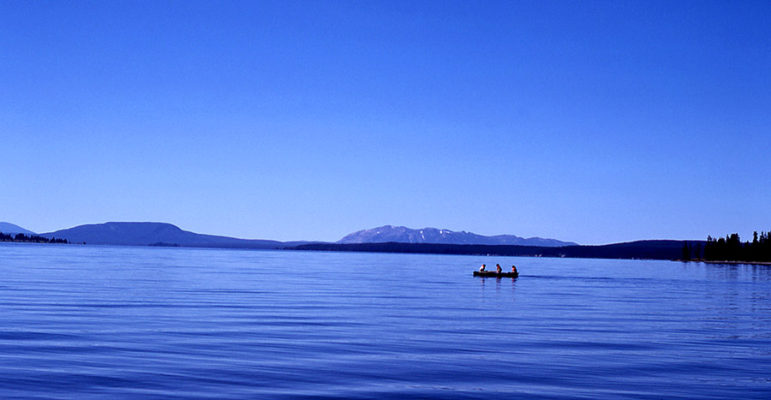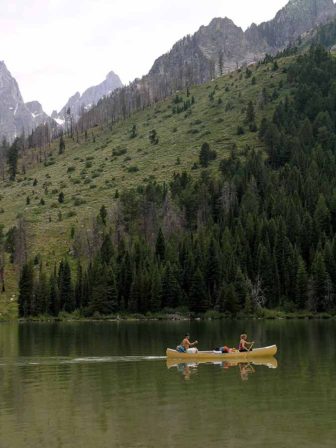
A new bill introduced by Wyoming Rep. Cynthia Lummis would nullify longstanding federal regulations that prohibit hand-propelled boating on rivers and streams in Yellowstone National Park and on some waters not currently open in Grand Teton National Park.
While the bill as initially drafted could potentially limit the authority of park superintendents to manage kayaking and other forms of paddling, Lummis said during a Congressional hearing last week that the final say over which rivers and streams are opened to paddling should rest with park managers.
“The intent is not to open all rivers all the time to paddling in the parks,” Lummis, a Republican and Wyoming’s lone delegate to the House of Representatives, said Thursday during a hearing in Washington, D.C. of the Subcommittee on Public Lands and Environmental Regulation.
“The intent of the bill is to remove a prohibition so paddlers can sit down with the superintendents of the parks and discuss where paddling makes sense, when it makes sense, and when it does not,” she said.
Lummis said she is “open to suggestions about how language could be drafted that makes the Park Service comfortable” that superintendents will have “authority to make these decisions pursuant to a plan.”
For decades, separate federal regulations specific to Yellowstone and Grand Teton have limited where visitors can paddle a canoe, kayak or other small boat.
Lummis questioned whether park managers have been “hiding behind” those regulations as a way to avoid engaging with paddlers in discussions.
Differing views
Not everyone agrees that opening more park waters to paddlers is a good idea. A May 2013 Environmental Assessment of a proposed Snake River management plan states that “there was no consensus as to how recreation on the river should be managed.”

“Some people encouraged opening more sections of the river to boating/paddling/floating, whereas others urged public land managers to close or keep closed certain river segments,” the report states.
In Yellowstone, any kind of watercraft is prohibited on park rivers and streams, except on the 3-mile channel between Lewis Lake and Shoshone Lake, which is open only to hand-propelled vessels. Anglers may use a float tube on rivers, but must buy a permit. Boating in both parks requires buying a permit.
In Grand Teton, hand-propelled vessels may be used on Jackson, Jenny, Phelps, Emma Matilda, Two Ocean, Taggart, Bradley, Bearpaw, Leigh, and String Lakes and on the Snake River. All other park waters are closed to boating.
Aaron Pruzan, a whitewater guide and outfitter in Jackson Hole, said during Thursday’s hearing that there are plenty of places in Yellowstone where paddling could be allowed without adverse effects on water, fish, wildlife or other visitors.
Pruzan said he supported tightening language in H.R. 3492 to give superintendents explicit authority to manage paddling as they do other activities. But he said paddling enthusiasts working to open Yellowstone’s rivers have “pretty much been stonewalled by the fact that this paddling ban exists.”
In a telephone interview after the hearing, Pruzan said there was a wide range of waters in both parks that would be appropriate for paddlers of every skill level.
In Grand Teton, the Snake is the only river open to paddling, but “there are stretches on the Buffalo Fork that would be nice, mellow floating, and tubing would be great on the Gros Ventre on a hot day,” he said.
Backcountry whitewater
In Yellowstone, stretches of the Black Canyon along the Yellowstone River are among the most coveted whitewater runs in the world, he said.
Packrafting, where hikers carry small, portable vessels into the backcountry, would allow for low-impact travel along remote waters where few others are likely to encounter them, Pruzan said.
Pruzan acknowledged that paddling isn’t appropriate along all waters in the parks. Floating the Yellowstone River through the Hayden Valley, for instance, could spoil the scenic vistas that enthrall photographers and motorists at roadside turnouts.
Access and fees could be managed through online reservation systems, as they are in other national parks, and superintendents could still close waters to protect wildlife, or for other compelling reasons, he said.
Pruzan said he didn’t want to see Yellowstone’s rivers opened to commercial rafting, like the Snake River in Grand Teton. But it made no sense, he said, to allow motorboats on Yellowstone’s large lakes and snowmobiles on winter trails while prohibiting kayakers from backcountry whitewater.
Bruce Sheaffer, comptroller for the National Park Service, said during Thursday’s hearing that his agency had not had time to review the bill and formulate a response. Sheaffer was on hand to address other bills related to funding, and said he lacked the expertise in natural resource issues needed to address the bill.
Yellowstone spokesman Al Nash said he was not sure of the reasons why river paddling was first prohibited in the park, but that the ban may date back to the 1950s. Pruzan and others have said the ban was initially enacted to help protect the park’s waters from overfishing, but that rules enacted since then now serve that purpose.
Grand Teton spokeswoman Jackie Skaggs said the issue of opening more of the park’s waters to paddling came up during the drafting of a Snake River management plan that will soon take effect.
“Some of the boaters may have felt like they weren’t heard, but their suggestions were taken into consideration and analyzed, and ultimately the proposed changes were dismissed,” she said.
The majority of waters in Grand Teton are open to paddlers, Skaggs said, and many who commented on the Snake River plan said they did not want to see paddlers in the backcountry or on newly opened waters.
Contact Ruffin Prevost at 307-213-9818 or [email protected].
